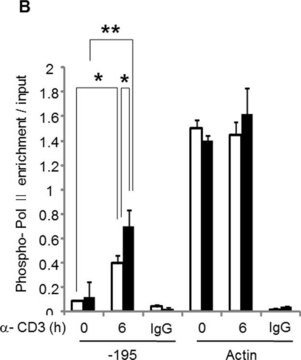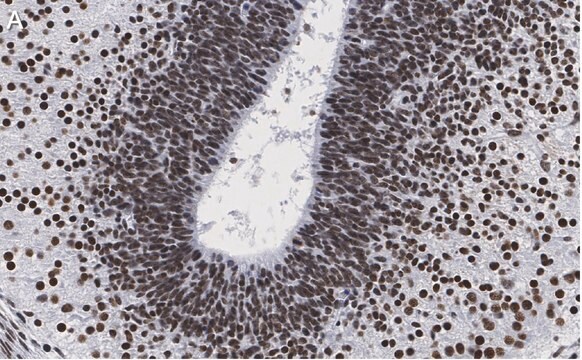05-952-I
Anti-RNA Polymerase II Antibody, CTD Antibody, clone 8WG16
clone 8WG16, from mouse
Sinônimo(s):
DNA-directed RNA polymerase II subunit RPB1, EC: 2.7.7.6, RNA polymerase II subunit B1, DNA-directed RNA polymerase II subunit A, DNA-directed RNA polymerase III largest subunit, RNA-directed RNA polymerase II subunit RPB1
About This Item
Produtos recomendados
fonte biológica
mouse
forma do anticorpo
purified immunoglobulin
tipo de produto de anticorpo
primary antibodies
clone
8WG16, monoclonal
reatividade de espécies
yeast, human
embalagem
antibody small pack of 25 μg
técnica(s)
dot blot: suitable
immunoprecipitation (IP): suitable
inhibition assay: suitable
western blot: suitable
Isotipo
IgG2aκ
nº de adesão NCBI
nº de adesão UniProt
modificação pós-traducional do alvo
unmodified
Informações sobre genes
human ... POLR2A(5430)
Categorias relacionadas
Descrição geral
Especificidade
Imunogênio
Aplicação
Epigenetics & Nuclear Function
Dot Blot Analysis: A representative lot detected RNA Polymerase II, CTD in Dot Blot applications (Thompson, N.E., et. al. (1989). J Biol Chem. 264(19):11511-20).
Immunoprecipitation Analysis: A representative immunoprecipitated RNA Polymerase II, CTD in Immunoprecipitation applications (Bhaumik, S.R., et. al. (2001). Genes Dev. 15(15):1935-45).
Inhibition Analysis: A representative lot inhibited the interaction of RNA Polymerase II, CTD with the transcription complex. (Thompson, N.E., et. al. (1989). J Biol Chem. 264(19):11511-20).
Qualidade
Western Blotting Analysis: 1 µg/mL of this antibody detected RNA Polymerase II, CTD in HeLa cell nuclear extract.
Descrição-alvo
forma física
Armazenamento e estabilidade
Outras notas
Exoneração de responsabilidade
Não está encontrando o produto certo?
Experimente o nosso Ferramenta de seleção de produtos.
Certificados de análise (COA)
Busque Certificados de análise (COA) digitando o Número do Lote do produto. Os números de lote e remessa podem ser encontrados no rótulo de um produto após a palavra “Lot” ou “Batch”.
Já possui este produto?
Encontre a documentação dos produtos que você adquiriu recentemente na biblioteca de documentos.
Nossa equipe de cientistas tem experiência em todas as áreas de pesquisa, incluindo Life Sciences, ciência de materiais, síntese química, cromatografia, química analítica e muitas outras.
Entre em contato com a assistência técnica








